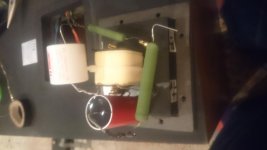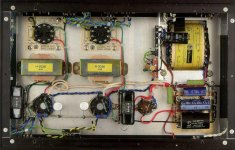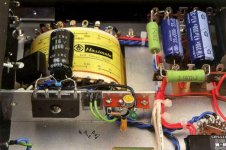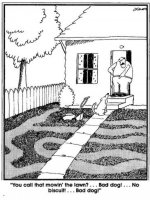Hiya,
I've just rebuilt the crossover on my speaker. I've gone for point to point soldering. I haven't fixed the caps or resistors to anything so they're kind of floating inside the box.
Is that a bad idea in terms of the sound Quality they'll give me?
Thanks
I've just rebuilt the crossover on my speaker. I've gone for point to point soldering. I haven't fixed the caps or resistors to anything so they're kind of floating inside the box.
Is that a bad idea in terms of the sound Quality they'll give me?
Thanks
Attachments
Last edited:
Sound quality? Probably not, I mean some components are microphonic and this may alter that, not necessarily better or worse. The inductors may be susceptible to an ambient field if they are moving.
I am not worried about sound quality much, but the vibration inside the speaker will eventually break the wires on the components. That is why they are normally anchored to either a circuit board or to a wooden slab. Resistors that can wiggle and shake will eventually snap the wires, just like bending a peper clip too many times will break the wire.
Always fix the components. It avoids damage to the components through vibration and most importantly it stops the components from rattling against the case making odd noises.
There is no problem with 'micro-phonics' as there is no amplifier after the crossover and ambient fields will result in un-noticeable differences. Use hot glue, ty-wraps or just collars and screws.
There is no problem with 'micro-phonics' as there is no amplifier after the crossover and ambient fields will result in un-noticeable differences. Use hot glue, ty-wraps or just collars and screws.
Christophe - that's actually quite a pretty build and all, but how is it applicable to a crossover inside a cabinet?
Most of the major components are either bolted directly to the chassis, the aluminum angle adjacent the power TX, or with very short leads to terminal strips or tube sockets. There are few -if any- components visible that aren't tightly constrained, and none will be subject to the vibrations existing inside a speaker enclosure.
Jon's suggestions are right on the money - with the caveat that if there are large power resistors for attenuation, hot-gluing those, or too close physical proximity to flammable materials could cause problems. This is very commonly seen in car audio systems, many of which lack protection fuses, and where over driving is not unheard off - when the little XO boxes are hidden away, it's often hard to see or smell when the magic smoke is let out.
Most of the major components are either bolted directly to the chassis, the aluminum angle adjacent the power TX, or with very short leads to terminal strips or tube sockets. There are few -if any- components visible that aren't tightly constrained, and none will be subject to the vibrations existing inside a speaker enclosure.
Jon's suggestions are right on the money - with the caveat that if there are large power resistors for attenuation, hot-gluing those, or too close physical proximity to flammable materials could cause problems. This is very commonly seen in car audio systems, many of which lack protection fuses, and where over driving is not unheard off - when the little XO boxes are hidden away, it's often hard to see or smell when the magic smoke is let out.
Christophe - that's actually quite a pretty build and all, but how is it applicable to a crossover inside a cabinet?
Oops sorry it was two similar threads at the same time & yes you are right.
http://www.diyaudio.com/forums/construction-tips/303343-looking-advice-point-point-construction.html
Better build filters on some support and put them outside a cabinets imho.
Greetings 🙂
this is my p2p....
Great p2p congratulations 🙂
This thread is about p2p & crossovers without support

- Status
- Not open for further replies.
- Home
- Design & Build
- Construction Tips
- Point to point without a pcb or support



